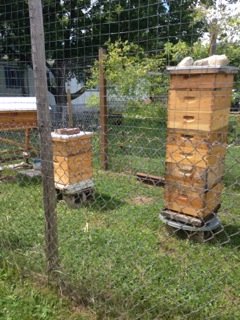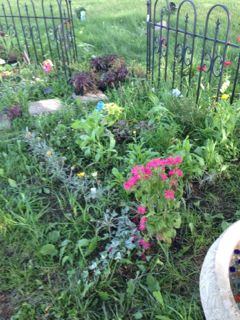Disease Control in your
Vegetable Garden
If your vegetables are being destroyed by disease it is important to take action.
One of the best preventions is to learn how to identify each, the damage they do, susceptible vegetables, and then you can find ways to prevent the problem in future seasons. Here is a list of some common diseases I have dealt with in my own gardens.
- dampening off - affects young seedlings - signs are plants die off and have weak whitish stems. I usually had to re seed and make sure I do not over water.
- white mold - affects seedlings - develops on the surface of wet potting soil. It is usually not harmful but may indicate over watering and/or poor air circulation.
- late blight - affects tomatoes - signs are black spots on leaves and fruit. Once you see blight take off affected leaves and fruit and put in the the garbage, not your compost. Blight can destroy plants very quickly. I live on the west coast and usually grow my tomatoes under cover now so the leaves do not get wet.
- clubroot - affects brassicas, root crops - signs are misshapen roots, wilting leaves, poor growth. Can live in the soil for many years so rotating your crops is important. Another way to keep this at bay is to make sure your soil has a good pH. Most veggie plants grow best with pH of 6-6.5
- powdery mildew- affects squash, zucchini, cucumbers - is a fungal disease and easy to identify. Infected plants display white powdery spots on the leaves and stems. Usually not harmful to the plant just not very attractive looking. I have cut off damaged leaves and make sure the plants have good air circulation around them.
- scab - affects potatoes - scab like growth are found on the potatoes. Not attractive to look at and potatoes need to be peeled to eat them. Do not lime the area where you grow potatoes as they prefer a more acidic soil.
- downy mildew - affects the foliage of cucumber, squash -caused by a fungus-like organism. It is spread from plant to plant by airborne spores. It is a disease of wet weather as infection is favoured by prolonged leaf wetness. Not usually harmful to the fruits. Pick off damaged leaves and put them in the garbage not your compost.
Practice to prevent disease
If you are having problems there are organic practices and preventions that can help. One of these practices is to attract beneficial bugs and insects to your garden.
- Provide safety in a place for them to live
- Have some kind of water feature or bath for them to use
- Provide food by planting beneficial flowers
There are strategies for control you can use to prevent any damage happening to your vegetable garden.
 Bees are a great addition.
Bees are a great addition.Encouraging beneficials into your garden is also very helpful.
- Beneficial animals:
- Birds – place bird house, feeders, water bowls; protect berries and fruits with netting.
- Bats – bat house, flattened bird house with an entrance slot on the bottom
- Toads – provide water and shelter with an upside down clay flower pot with holes chipped out on the sides for an entrance. The eat slugs.
- Snakes – pile rocks and sticks leaving room for snakes to enter. They eat slugs, snails, and insects.
-
Beneficial insects:
- Braconid wasps
- Earthworms
- Ground beetles
- Honeybees
- Ichneumon wasps
- Lacewings
- Lady bugs (ladybird beetles)
- Praying mantises
- Robber flies
- Spiders
- Syrphid flies
- Tachind flies
- Yellow jackets (hornets)
 Flowers are needed in the garden.
Flowers are needed in the garden.- Beneficial flowers:
- Marigolds
- Calendula
- Sunflower
- California poppy
- Flowers of dill, parsley
- Lemon balm
- Flowers of broccoli and celery
- Nasturtiums
Check out animal pests and insects for a list of common animal pests and insects that can cause damage to your vegetables.
